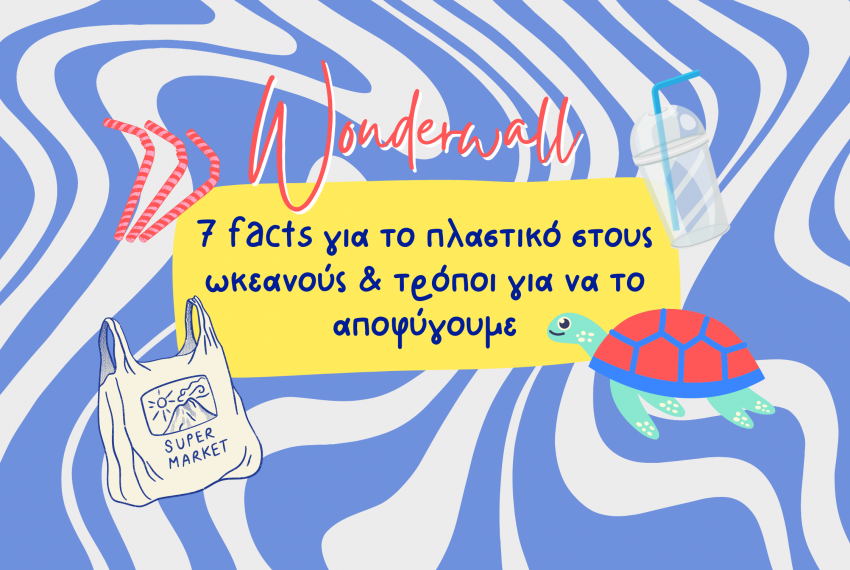Plastic is a man made material, cheap and easy to use. That's why we often choose it for convenience in our daily activities. But unfortunately a large amount of plastic ends up in the oceans and not only causes pollution but also harms the animals and aquatic nature as well as humans. Read 7 facts that you can share with your children in order to talk to them about the harm that plastic causes & discover ways and alternatives that you can use instead.
Over 8 million tons of plastic end up in the oceans every year
Every year we produce 380 million tons of plastic, 8 of which end up in the water. That is approximately the weight of 20 million elephants! 88% of the sea surface is covered by plastic waste.
It is estimated that the amount of plastic that ends up in the ocean every minute is equivalent to that of a full garbage truck. Plastic waste has been found as far as 11 kilometers deep, which means that people have managed to contaminate even the most remote places on the planet.
Plastic bottles and straws that end up in the sea can stay there for up to 450 years.
After the plastic decomposes, it turns into microplastics which are so small that they cannot be detected by the naked eye. While it's easy to pick up a plastic bottle and throw it away, microplastics are much harder to remove from water and are extremely harmful for sea life and humans.
1 in 3 fish caught for consumption is contaminated with plastic
The plastic that ends up in the ocean very often looks like fish food. 33% of fish are estimated to consume plastic which is harmful to their health.
Over 1 million seabirds and 100,000 marine animals die each year from causes linked to plastic pollution in the ocean.
Animals can become entangled and trapped in plastic traps and unlike us cannot escape or call for help. In addition, contact with microplastics found in water creates problems and diseases in marine organisms that are often irreversible.
Plastic in the oceans will triple by 2040
It is estimated that the current rates of use will triple in the oceans by 2040. However, if we change our habits immediately it will be reduced by 80%!
Plastic pollution will never decrease
This data is not 100% real and that is why we must immediately change our bad habits!
Although the current data is alarming, the situation is reversible. It is good to show children the real picture and explain to them how harmful a simple habit can be and how helpful to the environment it can be to remove a single piece of plastic from the beach. Children should take example from those around them, that is why we must show them how to be responsible for their planet. The beach offers us joy, fun and cool times. The space we use is shared so we must leave it exactly as we found it or even better. Always carry a bag with you for your waste. If you find garbage around, remove it.
You can use plastic alternatives, such as multi-purpose bottles that also keep water cold for many hours.
At The Wonder Room you will find the widest selection of reusable bottles, food containers and cutlery here.
The favorite Chillys bottles are a must for the beach: reusable bottles, made of durable materials that do not wear out and keep the water cold for 24 hours! Find them in designs and colors for the whole family and say goodbye to plastics!
And to avoid the "temptation" of using plastic, avoid taking it with you to the beach where it can be easily lost and difficult to recycle.
Another idea is to participate in volunteer cleanup days. Save Your Hood is a movement that articulates common ground where everyone can voice their ideas and concerns and empower each other for healthier neighborhoods. Over time, their audience grew with one common goal: picking up trash from…everywhere. For this purpose, it organizes garbage collection days from public places such as beaches. Young and old people gather to collect trash that some have "forgotten". It's a great way to learn that's also good for the environment.
And speaking of ways of learning, the educational value of the book takes form in this matter as well. "A sea of plastics" is the right book for this purpose. Through a beautiful fish story, it teaches about protecting the planet and the value of working together for a common purpose.
But also "Where does it all go?", is an excellent educational book with exciting ideas to save the environment. Starting with simple changes and easy things that have the ultimate goal of making the planet a better place!
The data for the future of the planet can sometimes seem very negative to us. But we must not forget that the generation that is growing up now is the one that has the power to overturn all the bad facts. That is why it is good to talk to them and show them real images. Thus, they will learn how to change the world, taking example from the good habits they see around them.
tag:Wonder Wall


